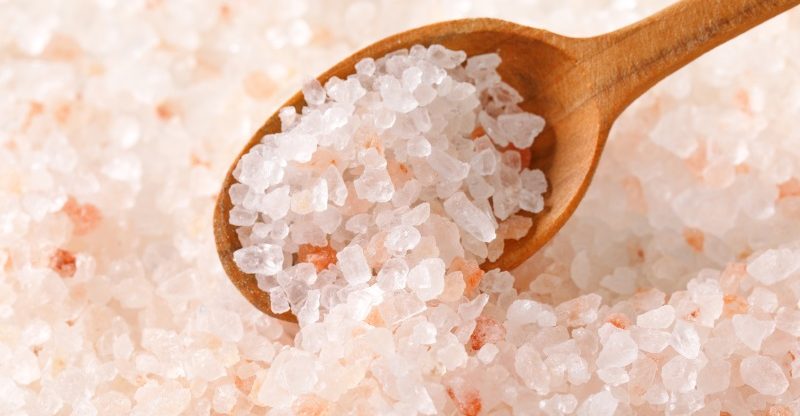9 Proven Benefits of Himalayan Salt Inhaler
Those who understand and embrace the healing power of salt, know the amazing health and wellness benefits of this ancient therapy.
Himalayan sea salt inhalers provide relief from several respiratory disorders.
They also help you to relax, sleep better and enjoy a healthier life.
If you have asthma, allergies, frequent respiratory infections or difficulty sleeping, then a salt inhaler could help you a great deal.
We examine the history of using sea salt as a therapeutic tool, as well as how salt inhalers work.
We will then discuss the many health and wellness benefits offered by a Himalayan salt inhaler.
Finally, we describe the proper use of a salt inhaler, so that you get the most benefit from this therapy.
Understanding Salt Therapy
The ancient Greeks were the first to use salt inhalation therapy.
However, the use of salt to treat various medical conditions goes much further back in time.
Ayurvedic medicine has used salt therapy for thousands of years to supply moisture to the sinuses and mucous membranes, as well as to prevent and treat illnesses and various allergies.
These practices are continued today in techniques such as nasal irrigation with Neti pots and similar tools.
When you spend time in the salty air, such as near the seashore, you probably notice that your skin and hair feel more moisturized.
For those with respiratory problems, like asthma, a day at the beach can help improve your ability to breathe easily.
In order to capture this feeling in other places, people have spent time in salt caves and salt-lined rooms to help relieve respiratory disorders.
Salt caves and mines have long been known to help improve health.
Polish salt miners in the 18th century were observed to have noticeably stronger immune systems and suffer from fewer breathing problems than others.
Those who now live near the ocean experience this same phenomenon.
Known as halotherapy to the ancient Greeks, the use of salt to treat respiratory ailments is becoming more popular today.
In addition to salt inhalers, which we cover extensively in this article, there are other forms of modern halotherapy.
These capitalize on the healing powers of salt, for use both internally and externally.
Epsom salt baths are an example of external halotherapy that relieves sore muscle pain.
Gargling with salt water helps with sore throats, and colonics are a type of internal salt water therapy.
Crenotherapy and the use of salt caves and rooms are all ways that halotherapy is still used today.
Another popular use of Himalayan salt is the salt lamp.
Made from large pieces of Himalayan salt crystals, combined with an electric light source, these lamps release negative ions into the room.
This purifies the air and provides a number of important health and wellness benefits.
Growing in popularity are man-made salt caves, where halotherapy is performed.
In these climate-controlled environments, temperatures are kept low and humidity is removed before microscopic salt particles are released into the air.
Those in the room then inhale the particles, which help to absorb bacteria, purify the air and improve respiratory function.
This type of therapy offers the same benefits as produced by a salt inhaler, which we detail next.
What is Salt Inhaler?
The introduction of Himalayan salt inhalers created a technique that combines old and new medical therapies to address modern respiratory issues.
The salt inhaler is a chamber that holds Himalayan salt crystals.
You breathe through the inhaler for a certain period of time, during which you are taking in microscopic particles of the healing, Himalayan sea salt with each breath.
The moisture naturally present in the air combines with these tiny particles in your lungs to moisturize your airway, lower inflammation, thin out excess mucus and control your histamine response.
This makes salt inhaler therapy perfect for those with asthma, COPD, bronchitis, allergies, hay fever, sinus problems or other upper respiratory infections.
Many with asthma and chronic breathing disorders regularly use steroid inhalers to control their breathing and reduce lung inflammation.
However, these medications come with many side effects, including increased blood pressure, feelings of nervousness or jitteriness and trouble sleeping.
Salt inhalers are effective but have none of these side effects.
This makes them an appropriate alternative for many people.
There are many retailers that sell both salt inhalers, as well as Himalayan salt to use inside your device.
Be sure to check that your salt provider adheres to strict quality standards and guarantees the purity of your salt.
Why Himalayan Salt?
If salt inhalers are effective, why is the type of salt you use important?
The reason is that Himalayan salt, found in the highest mountains in the world, is the purest of salt on the planet.
It also has a high concentration of minerals and elements that our bodies need.
The minerals in salt exist in colloidal form, which means they are suspended in tiny particles.
This makes them small enough to be able to be absorbed in the lungs when you inhale these particles.
Himalayan salt was formed millions of years ago in an ancient sea.
As the Earth’s crust shifted, the sea was raised high above the surrounding land to become the mountains, the ocean evaporated and it left behind this precious mineral.
Himalayan salt was protected from pollutants and heavy metals for millions of years.
This makes it a very pure form of salt.
It is still minimally processed after being hand-mined, which preserves its pristine nature.
Due to its purity and high mineral content, Himalayan salt is now used in many holistic and alternative healing applications.
When used internally or topically, Himalayan salt helps to regulate hydration and pH levels in the body, promotes healthy blood glucose levels, reduces cramping and promotes healthy kidney and gall bladder function.
This type of salt is also valued for its ability to promote vascular health, improve respiratory and sexual function and reduce the appearance of aging.
Is there anything that this natural compound can’t do?
Himalayan Salt Inhaler Benefits
Salt therapy used to require sitting in a salt cave for many hours.
However, you can now enjoy the same benefits in the comfort of your own home in just a few minutes each day.
Salt inhaler therapy does more than just promote better breathing.
It also helps to improve your mental and emotional health.
Some of the benefits of using a Himalayan salt inhaler are discussed below.
Lowered Inflammation
Salt is a natural anti-inflammatory.
Using a Himalayan salt inhaler help you reduce respiratory inflammation that contributes to asthma and COPD.
It is also helpful for reducing other sources of inflammation that can cause joint pain and other problems.
Lowering inflammation helps with several other issues, including allergies, arthritis, digestive problems, and headaches.
However, improved breathing and a decrease in wheezing and asthma flare-ups is the most significant benefit of this ancient, natural therapy.
Reduction in Allergy Symptoms
When you consistently use your Himalayan salt inhaler, you can reduce your natural histamine response in both the sinuses and lungs.
The salt inhaler helps to keep your nose and airways moisturized.
It coats and protects them from allergens.
By reducing your inflammatory response to histamines, you will experience less overall irritation from pollution, pet dander, pollen, and other airborne allergens.
Less Mucus and Congestion
If you have excess mucus in your throat, lungs or sinuses, using a salt inhaler can help.
Salt helps to thin and dry out excess mucus while keeping your mucous membranes moisturized.
This can help with many acute and chronic respiratory disorders, including colds, flu, bronchitis, asthma, COPD, pneumonia, and others.
Using a salt inhaler can also help with sinus infections, runny nose, and seasonal allergies.
Improved Sleep
When allergy or asthma symptoms are keeping you awake or interfering with your sleep, a Himalayan salt inhaler can help.
Regularly using a salt inhaler can help you to better control allergies and asthma.
It also has a relaxing effect that can improve your sleep.
By ending nighttime coughing, controlling congestion and relaxing your body, your salt inhaler will quickly become part of your nightly routine.
Reduced Infections
Salt has natural anti-fungal and antibacterial properties.
Using your salt inhaler can help you to fight any respiratory infections, which means you’ll be sick less often.
Body Detoxification
The minerals and compounds found in the Himalayan sea salt work as natural purifiers for the air you breathe, as well as for your body.
These minerals remove pollutants, smoke, dust, and smog, as well as other impurities inside your lungs.
Once in your body, they help to detoxify your other systems, flushing pollutants, and toxins from your blood and organs.
Reduced Stress
When you can breathe deeply and naturally, you are able to relax more fully.
By using a Himalayan salt inhaler and improving your respiratory function, you will also experience relaxation and stress-relieving benefits.
The routine of using your inhaler, sitting calmly and breathing deeply through your mouth for 20 minutes is a very relaxing habit.
When it is combined with the salt inhaler’s ability to improve your respiration and enhance your oxygen intake, it is easy to see why it will make you feel more relaxed and less stressed.
Lowered Blood Pressure
Using the Himalayan salt inhaler can also help you to regulate your blood pressure.
The high concentration of potassium in the salt crystals helps to lower blood pressure.
This is because potassium reduces the effects of sodium on the body, which is a significant contributor to hypertension.
Moisturized Membranes
A dry nose, throat, or airway can lead to coughing, bloody nose or sore throat.
Using the Himalayan salt inhaler regularly helps to moisturize all your mucous membranes and keeps these surfaces hydrated.
This is especially helpful in environments with recirculated air or that use electric heat, which can be very drying.
Precautions
As a natural treatment, halotherapy and the use of salt inhalers is generally considered to be very safe.
If you have asthma or another respiratory disorder and find that using your salt inhaler does not improve or makes your symptoms worse, you should stop using it.
While this is rare, it can happen.
The use of a salt inhaler is not meant to replace necessary medications that allow you to breathe safely.
Therefore, do not stop taking your prescribed medicines, until you have discussed it with your doctor.
Using a salt inhaler is also considered to be generally safe for women who are pregnant and children.
Be sure to monitor a child’s use of the inhaler, so that they are using it correctly and always exhaling through their nose.
Little medical research has been conducted on the uses and safety of salt inhalers and other forms of halotherapy.
Therefore, you should use these techniques with that understanding.
Conclusion
If you suffer from allergies, asthma or other respiratory issues, using a Himalayan salt inhaler regularly could dramatically improve your health.
Combining the natural health benefits of salt therapy with the purity of Himalayan salt, you can reduce your inflammation, improve your asthma and allergy symptoms and reduce your dependence on steroids and other types of medications.
Salt inhalers are effective for improving sleep, moisturizing your airways, lowering blood pressure, reducing infections and improving your sleep.
With just 20 minutes of inhalation therapy per day, you can soon enjoy better breathing.
FDA Compliance
The information on this website has not been evaluated by the Food & Drug Administration or any other medical body. We do not aim to diagnose, treat, cure or prevent any illness or disease. Information is shared for educational purposes only. You must consult your doctor before acting on any content on this website, especially if you are pregnant, nursing, taking medication, or have a medical condition.
HOW WOULD YOU RATE THIS ARTICLE?





